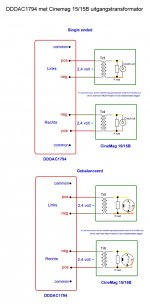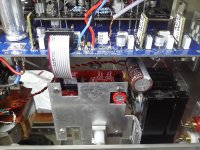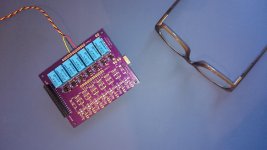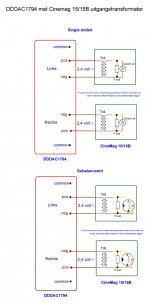Today my dddac has increased from four to eight boards. I keept my old boards and have now a mix of new and old boards. In the beginning the new boards sounds cold/sterile, but after a week or so they realy starts to shine. The shunt regs on the new boards give a very dynamic punch the old boards can not match and resolution and separation is top notch.
Regarding this, do you think that your old boards still contribute to the sound that the new ones are not capable of?
You earlier commentent of an analog caracter the new boards were not capable of at that time. Has that changed or not in your opinion?
Hard to say, but a friend of mine have only the new boards, and he experienced the same as me. After a week or more, the new boards sounds a lot better and is very detailed and dynamic without the sterile/cold signature they had in the beginning. The new boards sounds more like the old boards after 'burn in', but are a lot more detailed and dynamic.
Give the new boards some time before one concludes. I'm very happy with the sound now.
Give the new boards some time before one concludes. I'm very happy with the sound now.
Hello there, newbie allert 😀
First of all, i want you all to know that i've read this thread from top to bottom and for 90%+ it's all jibberisch to me but that doesn't mean that i didn't like what i've read.
but that doesn't mean that i didn't like what i've read.
So now you all know that i do not understand electronics 😱 i know how to solder though 😉
I build the new "PbT" dac in a "Duo" setup with only some minor upgrades:
An external double PSU with upgraded transformers (80VA and a 50VA).
Made a new cable for the Wave-io/motherboard communication from Cat 6.
The small capacitor upgrade on top of the dacboards.
Bought the Cinemags for more boost at the output stage.
There is more to come but i'll have to do this one step at a time, my wallet isn't that deep as some of you guys
All i want to say for now is that the PbT boards need a lot of time to get were they are supposed to get, my estimate is a 250 till 300 hours of burning time.
The first time i started this dac it sounded horrible but every day, when it churned away the hours (day and night) on automatic pilot so to speak, the sound got where i expected it it would end, and then got better and better....
This dac is simply amazing
I can only describe it as a digital machine that sounds analog but with all the benefits of digital equipment.
It makes bad sounding recordings much better sounding, how the hell is that possible
The good and very good recordings are way out there in image, soundstage, depth and detailing instruments then i ever heard before.
I want to thank Doede Douma for the brainwaves he got when he designed this o so musical dac and, i want to thank you lot, this small community of diehard DIY electronic experimentalists in upgrading this dac to what it has become today.
I'll get back at some point to give more impressions of the dac and post some pictures of my build.
I almost forgot, i do not think it is fair to compare the DDdac with anything commercial out there because it's like comparing apples with pears 😉 but that is my opinion.
By for now, Paulus
First of all, i want you all to know that i've read this thread from top to bottom and for 90%+ it's all jibberisch to me
 but that doesn't mean that i didn't like what i've read.
but that doesn't mean that i didn't like what i've read.So now you all know that i do not understand electronics 😱 i know how to solder though 😉
I build the new "PbT" dac in a "Duo" setup with only some minor upgrades:
An external double PSU with upgraded transformers (80VA and a 50VA).
Made a new cable for the Wave-io/motherboard communication from Cat 6.
The small capacitor upgrade on top of the dacboards.
Bought the Cinemags for more boost at the output stage.
There is more to come but i'll have to do this one step at a time, my wallet isn't that deep as some of you guys

All i want to say for now is that the PbT boards need a lot of time to get were they are supposed to get, my estimate is a 250 till 300 hours of burning time.
The first time i started this dac it sounded horrible but every day, when it churned away the hours (day and night) on automatic pilot so to speak, the sound got where i expected it it would end, and then got better and better....
This dac is simply amazing

I can only describe it as a digital machine that sounds analog but with all the benefits of digital equipment.
It makes bad sounding recordings much better sounding, how the hell is that possible

The good and very good recordings are way out there in image, soundstage, depth and detailing instruments then i ever heard before.
I want to thank Doede Douma for the brainwaves he got when he designed this o so musical dac and, i want to thank you lot, this small community of diehard DIY electronic experimentalists in upgrading this dac to what it has become today.

I'll get back at some point to give more impressions of the dac and post some pictures of my build.
I almost forgot, i do not think it is fair to compare the DDdac with anything commercial out there because it's like comparing apples with pears 😉 but that is my opinion.
By for now, Paulus
I have few suggestions, one of which I already posted before... remove everything from that metal cage, made of profiles and braces, and place it on a piece of wood.
Use MSR860G as rectifier diodes.
...
Nick
Care to explain the metal vs wood?
I'm building my DDDac into a Galaxy chassis from Modu, but as I originally got it for a different project it's a big small so I'm thinking about building another.
As I have more experience with wood I'm leaning to that as my material, and I have no 'earth' available at my mains socket so I guess it will improve safety.
So if I'm able to get sound improvement as well?
What makes the MSR860G a better choice that the original MBR 20200CT?
I dive into this world of electronics from the SW side so I'm still reading up.
Will increasing C1 or C3 improve sq or is it more helpfull to get a bigger trafo?
I see that smooth dancer and others highly recommends choke based power supply, but this seems to be rather expensive.
I see. So the Odroid does not generate that much noise by it self?Galvanic isolation on Ethernet side, CON2.
I assume that a mechanical disk will generate lots.
Building an improved power supply for the Odroid may be a step up from the original wall wart as well.
Use one of the original psu's doede make. A friend do this and it works fine on Odroid C2.
Ops,,,almost original, he has changed to a bigger trafo than the original. This change was done before Odroid was mounted, so it's possible that the original trafo will do fine too.
Ops,,,almost original, he has changed to a bigger trafo than the original. This change was done before Odroid was mounted, so it's possible that the original trafo will do fine too.
Care to explain the metal vs wood?
I'm building my DDDac into a Galaxy chassis from Modu, but as I originally got it for a different project it's a big small so I'm thinking about building another.
As I have more experience with wood I'm leaning to that as my material, and I have no 'earth' available at my mains socket so I guess it will improve safety.
So if I'm able to get sound improvement as well?
What makes the MSR860G a better choice that the original MBR 20200CT?
I dive into this world of electronics from the SW side so I'm still reading up.
Will increasing C1 or C3 improve sq or is it more helpfull to get a bigger trafo?
I see that smooth dancer and others highly recommends choke based power supply, but this seems to be rather expensive.
I see. So the Odroid does not generate that much noise by it self?
I assume that a mechanical disk will generate lots.
Building an improved power supply for the Odroid may be a step up from the original wall wart as well.
With regard to metal vs. wood, I suggest you try for yourself and see if you can notice the difference. The good thing about DDDAC is that it can be mounted on anything and it also looks pretty good.
The MSR860G provides very relaxed and natural sound, with very good detail retrieval. Compare the specs for MBR20200CT and MSR860G and you will see the difference black-on-white.
Smoothing capacitors / transformers question is difficult to answer… I found that Talema transformers supplied in a kit, sound really nice and open compared to anything else I tried. I also prefer properly decoupled Doede's power supply compared to chokes loaded supply. My capacitors' selection consists of Cerafine II and Cerafine Super Gold in combination with BlackGates N and smd decoupling capacitors instead of standard WIMA's that are supplied in a kit. So, quite a different capacitors complement from the original which I find very unpleasant. The main trick is in a type, value and placement of smd capacitors that gives the lowest noise AND also the desired sound characteristics. This will make huge difference in sound. Also, Super Gold are very expensive, but they do sound very nice and relaxed. Black Gates N types are outstanding but not manufactured any more…. Close replacement would be Silmic II…. but this could result in sound that is a bit mellow and vague. You can try different types / combination for yourself and see what produces best sound in your system. The whole exercise can be very costly at the end, but is worth the money and effort. DDDAC can produce excellent drive, fantastic low end, and crystal clear highs which is very good for a NOS design that struggles with linear output response and the "percepted" high frequency extension. All this can be fine-tuned purely by utilizing different types, placement and values of SMD decoupling caps on the power supply boards.
Thanks Nick,Black Gates N types are outstanding but not manufactured any more…. Close replacement would be Silmic II…. but this could result in sound that is a bit mellow and vague. You can try different types / combination for yourself and see what produces best sound in your system.
Have you tried the Audio Note KAISEI? Lowest value they do for now is 100uf 100v. If you believe the marketing, these are reported to be produced by the Rubycon team who made the Black Gates and use the same electrolytic.
Do you have any pictures of your dddac and power supplies so we can see how you've modded them?
Also, do you have a preference for caps to use for the vcom on the dddac?
thanks,
James
With regard to metal vs. wood, I suggest you try for yourself and see if you can notice the difference. The good thing about DDDAC is that it can be mounted on anything and it also looks pretty good.
...
Thanks for the reply.
I'll play around a bit with it.
Guess testing with MSR860G and mounted on wood will be the first tests.
Then I got to make the Odroid C2 play music over i2s.
But first I'll just listen to some music 🙂
Have anyone tested with various quality spdif sources and gotten an idea on the effect on sq?
It did improve my old H/K dvd25 alot but atm I don't have any other coax spdif sources to compare against.
Can any one give me the connection schematic diagram for putting in the Cinemag transformers with the DDDAC? I have the older motherboard (RED) one. In case there are any specific things to keep in mind while making a change from capacitors to trafos.
Cheers.
Cheers.
Hello,
I have been thinking about a modification to the motherboard. Now the big cap on the motherboard supplies voltage to the regulators on the small boards and the 3 regulators on the mainboard.
I already did change the 3 on the motherboard into the ones from Belleson. Now i want to add an LC network after the big cap, cutting the traces to these regulators to they can be '' supplied '' by their own cap.
Because of limited space in the area near the big cap i can not put a choke with dimensions of the Lundahl. The belleson regulators each have their own bleeder resistor because there is a minimum current to make them work perfectly so total current going into the motherboard power supply will be close to 60 mA.
Doede told me it could be a nice improvement and Brian from Belleson told me to use the lowest dcr choke ( do have 500mH,30ohm,300mA and 1000mH,40 ohm, 240mA hammonds in the attic) from the ones i have in stock. 500mH would already filter a lot. Have some Black gate 100µF N type i could use after the choke. The hammonds are small and can be mounted on the motherboard using one of the mounting holes on the board that are not in use because my boards are mounted onto the chassis using the holes in the smaller boards.
Greetings, eduard
p.s as you can see the wave IO is ready to be used will get an Aurender soon.
I have been thinking about a modification to the motherboard. Now the big cap on the motherboard supplies voltage to the regulators on the small boards and the 3 regulators on the mainboard.
I already did change the 3 on the motherboard into the ones from Belleson. Now i want to add an LC network after the big cap, cutting the traces to these regulators to they can be '' supplied '' by their own cap.
Because of limited space in the area near the big cap i can not put a choke with dimensions of the Lundahl. The belleson regulators each have their own bleeder resistor because there is a minimum current to make them work perfectly so total current going into the motherboard power supply will be close to 60 mA.
Doede told me it could be a nice improvement and Brian from Belleson told me to use the lowest dcr choke ( do have 500mH,30ohm,300mA and 1000mH,40 ohm, 240mA hammonds in the attic) from the ones i have in stock. 500mH would already filter a lot. Have some Black gate 100µF N type i could use after the choke. The hammonds are small and can be mounted on the motherboard using one of the mounting holes on the board that are not in use because my boards are mounted onto the chassis using the holes in the smaller boards.
Greetings, eduard
p.s as you can see the wave IO is ready to be used will get an Aurender soon.
Attachments
Yes, an Aurender musicstreamer with the DDDAC1794 is a dreamteam. Use it for a half year now and realy do not want to go back to a conventional pc-based application...
Passive transformer volume control
Progress!
I have fitted relays 1-7 on the first prototype board and programmed the Arduino to read the position of the volume pot and activate the according relay. Seems to work nicely so far.
The attached a sneak peek shows the first board with relays 1-7 installed (the final unit will have two boards with 27 relays in total). The Arduino is stacked under the board, so you can't see it on the photo.
I am in the process of building a TVC control with 27 relay switches that are controlled by an Arduino microcrontroller. It's intended to work my Sowter 9335 transformer, but other transformers will also work. Doede already tested the 9335 on his AP analyzer with the DDDAC, and it performed very well.
I built the first prototype on a perf board (which was a major PITA), and that seems to work well. In the end, the whole thing is intended to live on two PCB "decks" that are stacked on each other, and are plugged onto the Arduino. The overall concept is very similar to Doedes design, but without source selection (and I believe it will be physically smaller).
I am currently waiting to receive the first PCB boards for the firsd "deck" that will deal with relay switches 1-14. Once I get this working, I will finish the second board. In the end I will probably have some extra boards because OshPark wants me to order at least three boards.
Progress!
I have fitted relays 1-7 on the first prototype board and programmed the Arduino to read the position of the volume pot and activate the according relay. Seems to work nicely so far.
The attached a sneak peek shows the first board with relays 1-7 installed (the final unit will have two boards with 27 relays in total). The Arduino is stacked under the board, so you can't see it on the photo.
Attachments
Yes, an Aurender musicstreamer with the DDDAC1794 is a dreamteam. Use it for a half year now and realy do not want to go back to a conventional pc-based application...
Hello,
I know Doede, the man himself is using Aurender too.
a pity you have to get an apple device to be able to use the aurender app. I did see on you tube how it works and surely looks nice!!
One of the dealers told me to use DBpoweramp to rip my cds on my windows pc. Have to get an ethernet cable to connect the aurender to my router. Will be a few hours work to hide this cable from view. Or can use an accesspoint to have the aurender connected by wifi to my router?
Anyone else using the aurender??
greetings, eduard
Aurender can be used with both Apple and Android app's. I Guess you mistaken Aurender here with Auralic, that only can be used with an iPad.
Aurender can be used with both Apple and Android app's. I Guess you mistaken Aurender here with Auralic, that only can be used with an iPad.
Hello,
The Aurender Conductor has been developed and designed to utilize the full screen of the iPad screen. Conductor App for Android devices is available with limited functionality. iPhone version is not available as of now.
This is copy and paste from FAQ from aurender website.
Will have to ask the dealer again i guess. Probably just needs a basic i pad not one with the latest gimmicks
Greetings, eduard
Thanks Arieson. I was also able to get this diagram off of creative's website. I was just checking in case there are any additional pointers that I need to bear in mind before starting working on this change.Yes we can...
Yes we can...
How and where do you (not) connect things to chassis / GND?
And can someone please translate the dutch comments?
Attachments
Progress!
I have fitted relays 1-7 on the first prototype board and programmed the Arduino to read the position of the volume pot and activate the according relay. Seems to work nicely so far.
The attached a sneak peek shows the first board with relays 1-7 installed (the final unit will have two boards with 27 relays in total). The Arduino is stacked under the board, so you can't see it on the photo.
Nice work keen to see how it progresses! I'm assuming the strategic placement of the spectacles has some symbolic meaning 🙂
Sent from my 486 IBM WIN 3.1x Desktop...
- Home
- Source & Line
- Digital Line Level
- A NOS 192/24 DAC with the PCM1794 (and WaveIO USB input)



